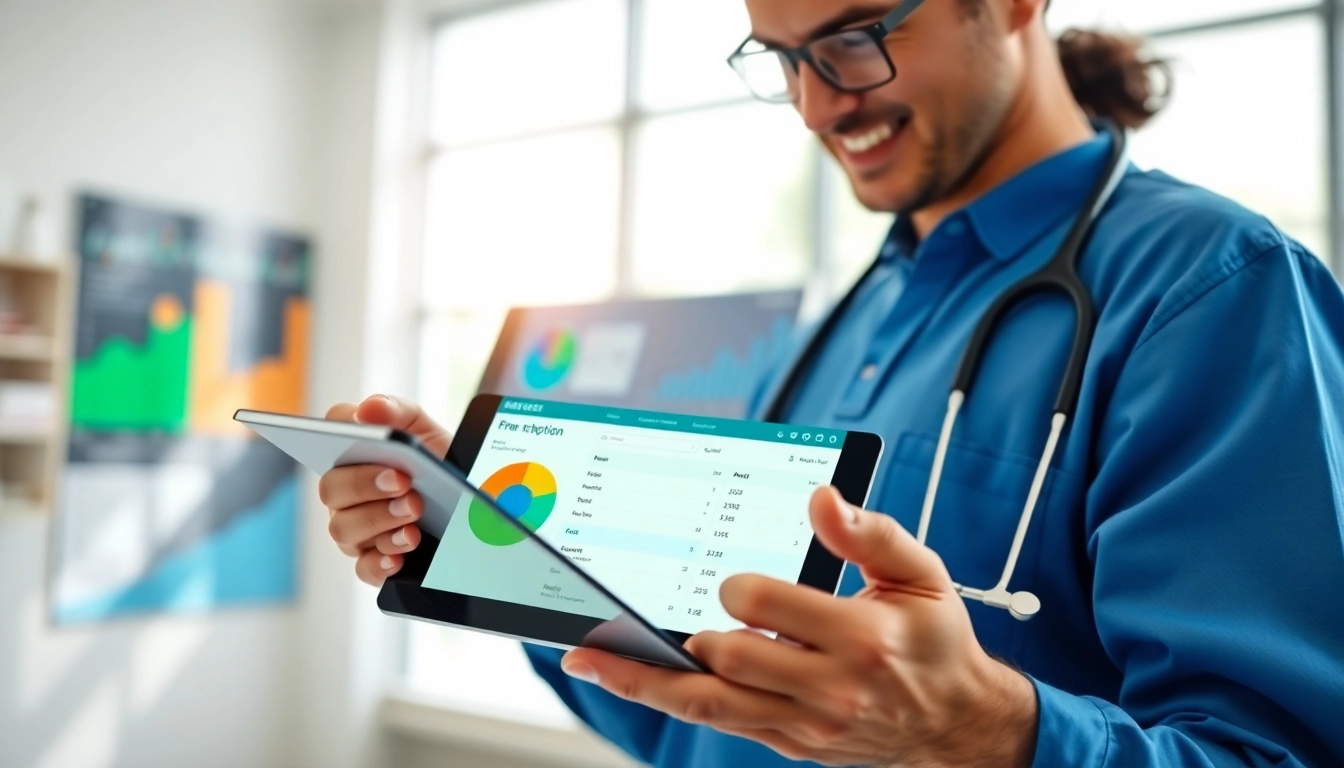Understanding Eprescribing Software
Eprescribing software has revolutionized the way healthcare providers prescribe medication, enabling them to reduce errors, streamline workflows, and enhance patient safety. This technology allows for the electronic creation and transmission of prescriptions, making it a pivotal tool in modern medical practice. With the increasing prevalence of this technology, understanding its features, benefits, and implementation strategies is essential for healthcare professionals seeking to optimize their operations. The integration of an eprescribing software into healthcare practices can significantly enhance the quality of care delivered to patients.
What is Eprescribing Software?
Eprescribing software is an electronic system that enables healthcare providers to write and send prescriptions directly to pharmacies via digital means. This technology facilitates a more efficient prescribing process, allowing for immediate communication and confirmation of medications. Unlike traditional paper prescriptions, which are prone to misreading or loss, e-prescribing enables the direct transmission of accurate prescription data to pharmacies, minimizing potential errors and improving patient safety.
Key Features of Eprescribing Software
Modern eprescribing software is equipped with numerous features designed to streamline the prescribing process and enhance user experience. Some of the key features include:
- Drug Interaction Checking: The software can automatically cross-reference prescribed medications with a patient’s medical record to highlight potential drug interactions or allergies.
- Prescription History Management: Providers can access a patient’s prescription history, allowing for more informed prescribing decisions based on previous medications.
- Formulary Checks: Eprescribing systems can verify medication coverage by checking against the patient’s insurance formulary, ensuring prescribed drugs are covered by their plan.
- Electronic Prior Authorization: Some systems enable healthcare providers to submit prior authorization requests electronically, speeding up the approval process for certain medications.
- Patient Communication Tools: Many eprescribing systems include features that facilitate communication with patients regarding their prescriptions, including refill reminders and alerts.
Benefits of Using Eprescribing Software
The adoption of eprescribing software offers a myriad of benefits for healthcare providers, patients, and pharmacies alike. Here are some of the standout advantages:
- Improved Accuracy: By eliminating handwritten prescriptions, eprescribing reduces the risk of transcription errors, ensuring that patients receive their medications as intended.
- Enhanced Efficiency: The electronic transmission of prescriptions expedites the process, reducing wait times for patients and improving the overall efficiency of pharmacy operations.
- Better Patient Safety: Eprescribing software enhances patient safety by providing alerts for potential drug interactions or allergies, thereby supporting informed prescribing decisions.
- Convenience: Patients benefit from the convenience of having prescriptions sent directly to their pharmacy of choice, enabling them to pick up medications without the hassle of paper prescriptions.
- Cost Savings: Eprescribing can lead to significant cost savings for healthcare systems by reducing the number of adverse drug events and streamlining operations.
Implementation of Eprescribing Software
Choosing the Right Eprescribing Software for Your Practice
The selection of the right eprescribing software is crucial to its successful implementation. When evaluating options, healthcare providers should consider several factors:
- Compatibility: Ensure that the software is compatible with your existing electronic health record (EHR) systems for seamless integration.
- User-Friendly Interface: A user-friendly interface can significantly enhance adoption rates among healthcare staff and minimize the learning curve.
- Support and Training: Consider the level of customer support and training offered by the software vendor to ensure staff can utilize the system effectively.
- Regulatory Compliance: The software must comply with relevant regulations, such as HIPAA, to ensure the security and privacy of patient information.
- Cost-Effectiveness: Evaluate the costs associated with purchasing, implementing, and maintaining the software against the potential savings it could provide.
Step-by-Step Implementation Process
Implementing eprescribing software involves several key steps that can facilitate a smoother transition:
- Needs Assessment: Conduct a thorough evaluation of your practice’s needs and objectives to define what you want to achieve with eprescribing software.
- Research and Selection: Research various software options, comparing features, costs, and user reviews to find the best fit for your practice.
- Pilot Program: Consider conducting a pilot program with a small group of users to assess the software’s functionality and gather initial feedback.
- Training: Provide comprehensive training for all staff members who will be using the software, emphasizing practical use cases and troubleshooting tips.
- Full Implementation: Roll out the software across the entire practice, ensuring ongoing support and communication to address any issues that arise post-launch.
Integration with Existing Systems
Successful integration of eprescribing software with existing electronic health record (EHR) systems is essential for maximizing its benefits. Effective integration allows for streamlined workflows and data consistency. Here are some strategies for successful integration:
- Collaboration with IT Professionals: Work closely with IT staff or consultants to ensure a smooth integration process and to troubleshoot any technical issues.
- Data Migration: Plan for the transfer of existing prescription data into the new system to ensure continuity of care and maintain patient history.
- Regular Updates: Keep software up to date to ensure compatibility with other systems, regulatory compliance, and access to the latest features.
Best Practices for Eprescribing Software Usage
Maximizing Efficiency with Eprescribing Software
To fully harness the potential of eprescribing software, healthcare providers must adopt best practices that facilitate efficient usage:
- Streamlined Workflows: Optimize workflows by integrating eprescribing into daily routines, ensuring that all team members are aware of processes.
- Utilize Alerts and Reminders: Leverage built-in alerts for medication interactions or patient follow-ups to enhance patient care and adherence.
- Regular Feedback: Encourage feedback from staff regarding the usability of the system and make adjustments as needed to improve efficiency.
Ensuring Compliance and Security
Compliance and security are paramount when using eprescribing software. Healthcare providers should adhere to the following guidelines:
- Data Encryption: Ensure that all patient data is encrypted both in transit and at rest to protect sensitive information from unauthorized access.
- Access Controls: Implement strict access controls so that only authorized personnel can access prescription data, enhancing security measures.
- Regular Audits: Conduct periodic audits of the software and usage patterns to ensure ongoing compliance with regulatory standards.
Training Staff for Effective Software Utilization
Thorough training is essential for maximizing the capabilities of eprescribing software. Best practices include:
- Comprehensive Training Programs: Develop structured training sessions that cover all functionalities of the software, tailored to the various roles of staff members.
- Ongoing Education: Provide continuous education opportunities to keep staff updated on new features and best practices as the software evolves.
- Creating a Resource Hub: Maintain a readily accessible resource hub with manuals, FAQs, and troubleshooting tips to aid staff as they use the software.
Challenges and Solutions in Eprescribing Software
Common Challenges Faced by Healthcare Professionals
While eprescribing software offers numerous advantages, there are challenges that healthcare professionals may face, including:
- Resistance to Change: Some staff may resist transitioning from traditional prescribing methods to electronic systems.
- Technical Issues: System downtime and technical glitches can disrupt workflows and frustrate users.
- Data Privacy Concerns: Healthcare professionals may have concerns regarding the security and privacy of patient information in digital formats.
Effective Solutions to Overcome Hurdles
Addressing challenges requires strategic solutions, such as:
- Change Management Strategies: Implement comprehensive change management strategies that emphasize the benefits of e-prescribing and involve staff in the transition process.
- Robust IT Support: Ensure that there is always reliable IT support available to resolve technical issues promptly and reduce disruption.
- Enhancing Data Security Measures: Institute rigorous data security practices and training to reassure staff and foster trust in the system.
Case Studies of Successful Eprescribing Implementations
Examining successful implementations of eprescribing software can provide valuable insights into best practices:
- Case Study 1: A pediatric clinic implemented eprescribing software and reported a reduction in prescription errors by over 30%. The clinic attributed this success to comprehensive training sessions and involving staff in the software selection process.
- Case Study 2: A multi-specialty practice leveraged eprescribing software to streamline patient workflows, significantly improving patient satisfaction scores due to reduced wait times and improved communication between providers and pharmacies.
The Future of Eprescribing Software
Emerging Trends in Eprescribing Technology
The landscape of eprescribing software continues to evolve, with several emerging trends shaping its future:
- Integration with Artificial Intelligence: Future eprescribing systems are likely to incorporate AI to provide more personalized prescribing recommendations based on patient data.
- Telehealth Integration: As telehealth becomes more prevalent, eprescribing software will increasingly integrate with telehealth platforms to facilitate prescriptions during virtual consultations.
- Blockchain for Enhanced Security: The potential for blockchain technology to improve data security and interoperability is an exciting emerging trend in the realm of health information technology.
Impact of Eprescribing Software on Patient Care
The impact of eprescribing software on patient care is profound and multifaceted. By improving the accuracy and efficiency of medication prescriptions, healthcare providers can enhance the overall quality of patient care:
- Increased Adherence: Patients are more likely to fill their prescriptions and adhere to treatment plans when the process is streamlined and efficient.
- Better Coordination of Care: Eprescribing allows for better coordination among multiple healthcare providers, reducing the risk of medication errors.
- Improved Patient Education: Integrated features can facilitate better patient education regarding their medications, increasing understanding and empowerment in their health management.
Anticipating Changes in Regulations and Standards
The regulatory landscape surrounding eprescribing is continually evolving, and healthcare providers must stay abreast of changes that could impact their practices:
- Increased Compliance Requirements: Providers can expect more stringent compliance requirements related to data privacy and electronic record-keeping.
- Promotion of Interoperability: Future regulations will likely promote greater interoperability among various health information systems, enabling easier data exchange between providers and pharmacies.
- Adoption of National Standards: The establishment of national standards for eprescribing may be introduced to enhance the consistency and reliability of electronic prescriptions across different systems.














Leave a Reply